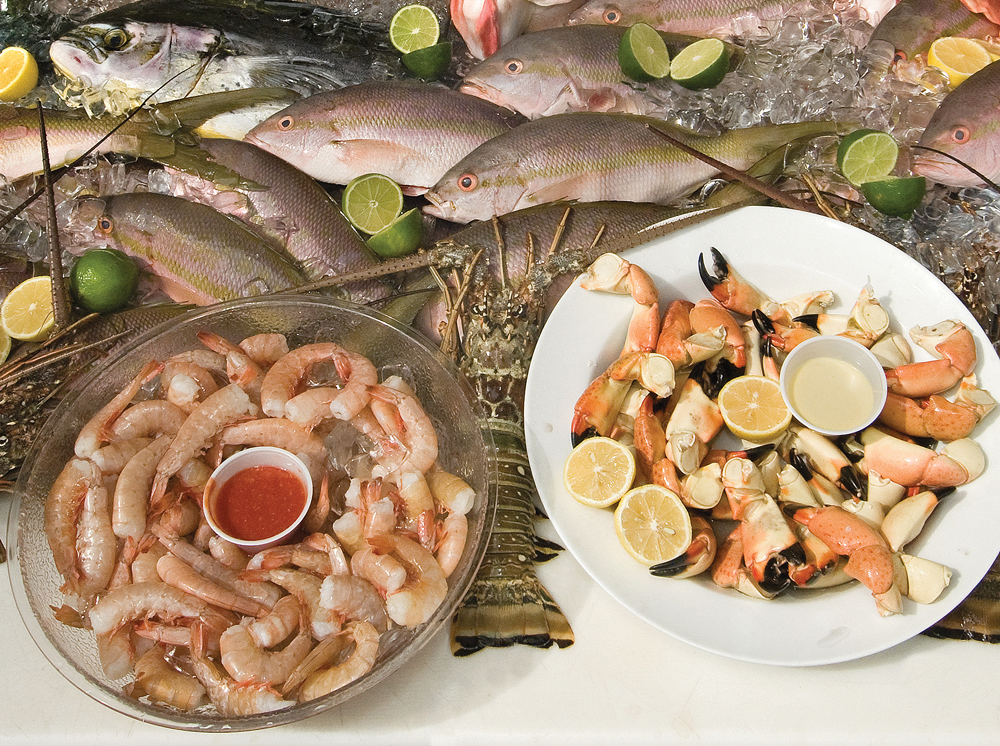Indigenous Florida Keys cuisine is rich in fresh boat-to-table seafood, enhanced with the light tropical flavors of lime, coconut, mango and papaya. Four delicious foods can be considered signature treats that are best savored only in the Keys: stone crab, pink shrimp, lionfish and Key lime pie.
Stone crabs, renowned for their sweet and succulent claw meat, are popular during an annual harvest season that runs Oct. 15 to May 15. The Keys are Florida’s leading regional supplier of the hardy crab claws, which are considered a renewable or sustainable seafood resource because of the crabs’ ability to regrow them.
Since nearly all of a crab’s meat is in its claws, these are the only parts harvested. Fishermen then return the crabs to the sea, where claws can regenerate over a two-year period.
Stone crab claws can be served warm with drawn butter or chilled with mustard sauce. Claw meat is also used to make crab cakes, fritters and wonderful stuffing for fresh fish.
There’s even a Stone Crab Eating Contest in the Keys each October. It takes place at Keys Fisheries, a rustic waterfront dining venue, market and wholesale fishery in Marathon.
Key West pink shrimp are another top local delicacy, generally considered sweeter than other shrimp. “Key West pinks” can be sautéed in scampi, battered and fried, or nestled atop salad or pasta. They can also be simply steamed or boiled, served with savory sauces and seasonings, and garnished with lime, lemon or fresh herbs.
Stock Island, lying just across Cow Key Channel from Key West, is a hub of the Florida Keys’ commercial shrimping industry. Wild-caught pink shrimp are harvested from the clear blue waters of the Dry Tortugas north along the west coast of the Keys.
Lionfish, with a delicate flavor and light flaky white meat, tastes similar to yellowtail snapper, grouper and hogfish. The invasive Indo-Pacific species, a venomous and toothy coral reef fish that’s wildly prolific, can be found in both deep and shallow waters. Recognizable by dark red and white stripes, lionfish have no known predators in the Keys except humans.

The Key Lime Festival’s David Sloan shows off a gourmet pie to a very interested buddy. (Photo by Rob O’Neal)
What to do with these invasive undesirables? Eat ‘em! Predator-deterrent venomous spines are removed before cooking, and the meat is perfectly safe and very tasty.
Several Keys restaurants, including Chef Michael’s in Islamorada and Castaway Waterfront Restaurant & Sushi Bar in Marathon, feature lionfish dishes. Try it as sushi or “wrecker” style in a sauce of capers, garlic, butter and diced tomato.
Capturing lionfish during recreational scuba dives or organized “derbies” helps preserve native Keys habitats and ecosystems. The 2018 Key Largo Lionfish Derby, sponsored by the Reef Environmental Education Foundation, is scheduled Sept. 14-16 at John Pennekamp Coral Reef State Park. REEF’s director of special projects, Lad Akins, has even authored “The Lionfish Cookbook” with Tricia Ferguson.
No meal is complete without the destination’s signature dessert of melt-in-your-mouth Key lime pie — which is so popular that it was designated Florida’s official state pie in 2006. Experts believe Key lime pie was born in Key West in the late 1800s, reputedly made by “Aunt Sally,” the cook for prominent resident William Curry — known as Florida’s first millionaire.
A true Key lime pie typically tastes tart yet creamy. Ingredients are simple: sweetened condensed milk, egg yolks, juice of the tart and aromatic Key limes, and a crust crafted of butter and graham crackers. Egg yolks give the pie its yellowish coloring; green-hued pies are not authentic.
A popular Key West summer event, the Key Lime Festival, celebrates the beloved fruit. Typically staged July 4 weekend, it features the famed Mile High Key Lime Pie Eatin’ Contest where competitors race to devour a 9-inch pie faster than their fellow entrants.
If you’re craving Keys cuisine, make vacation plans now — because every day in the welcoming island chain is a day for feasting on the ocean’s bounty topped off by Key lime goodness.


